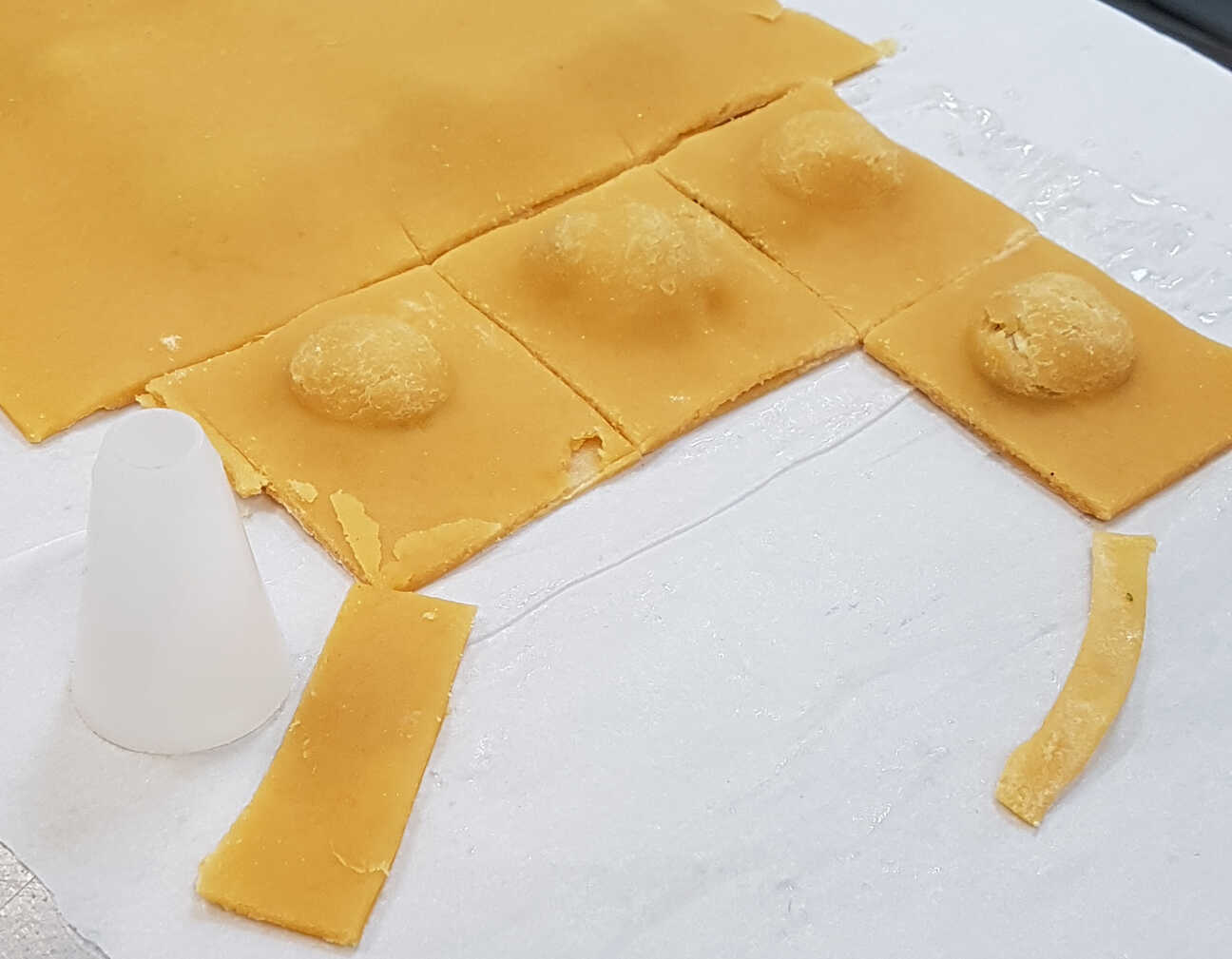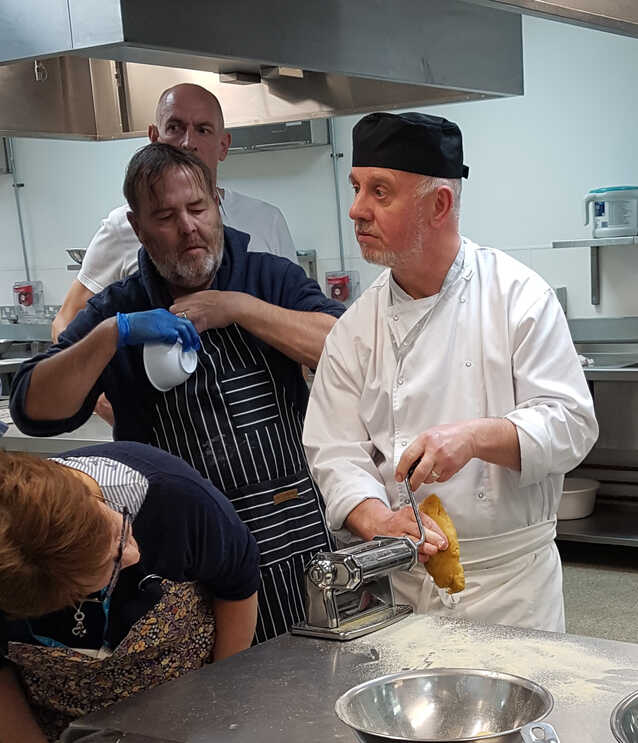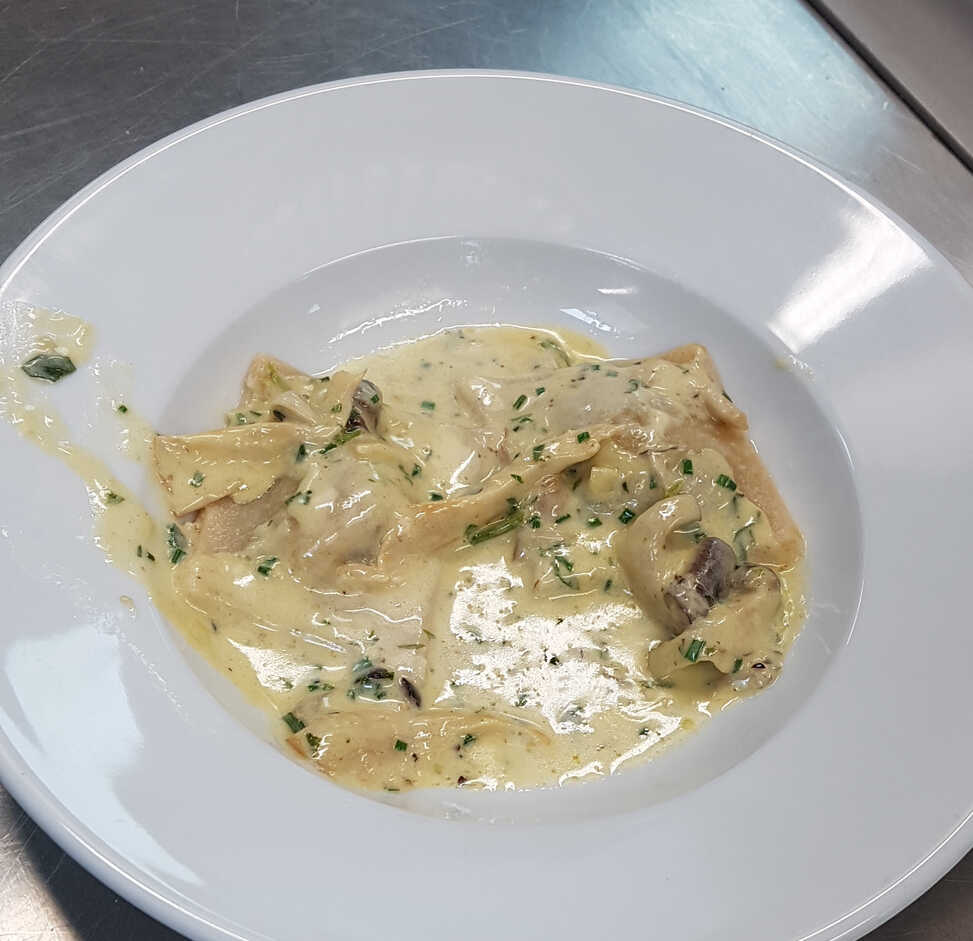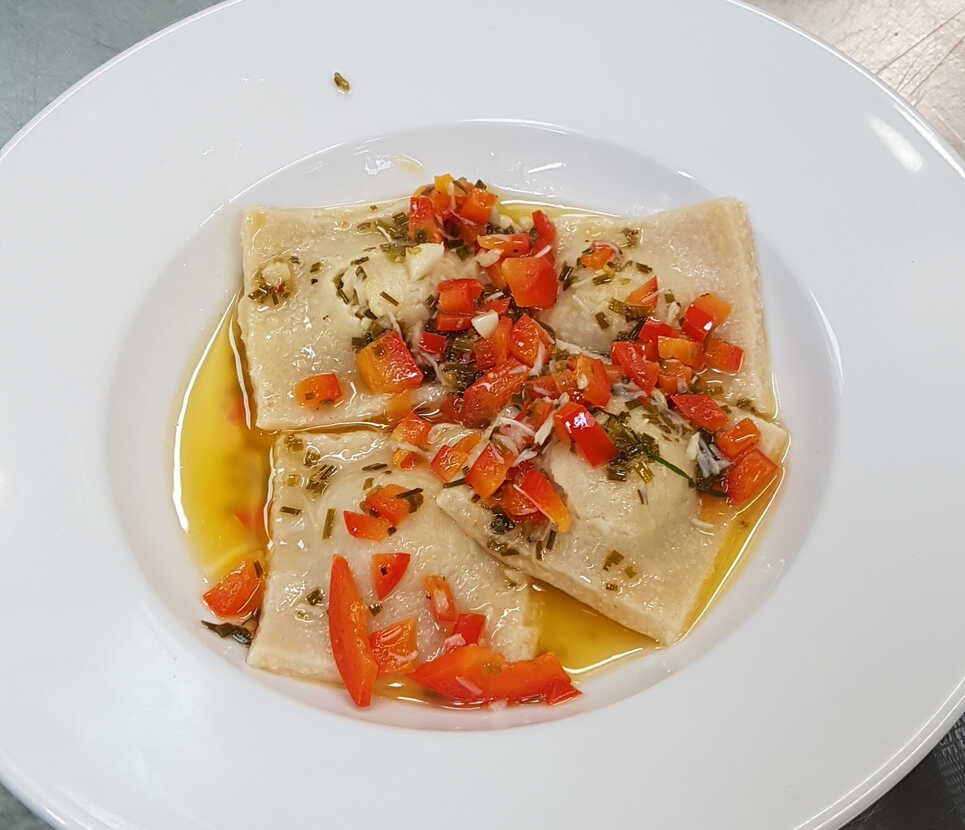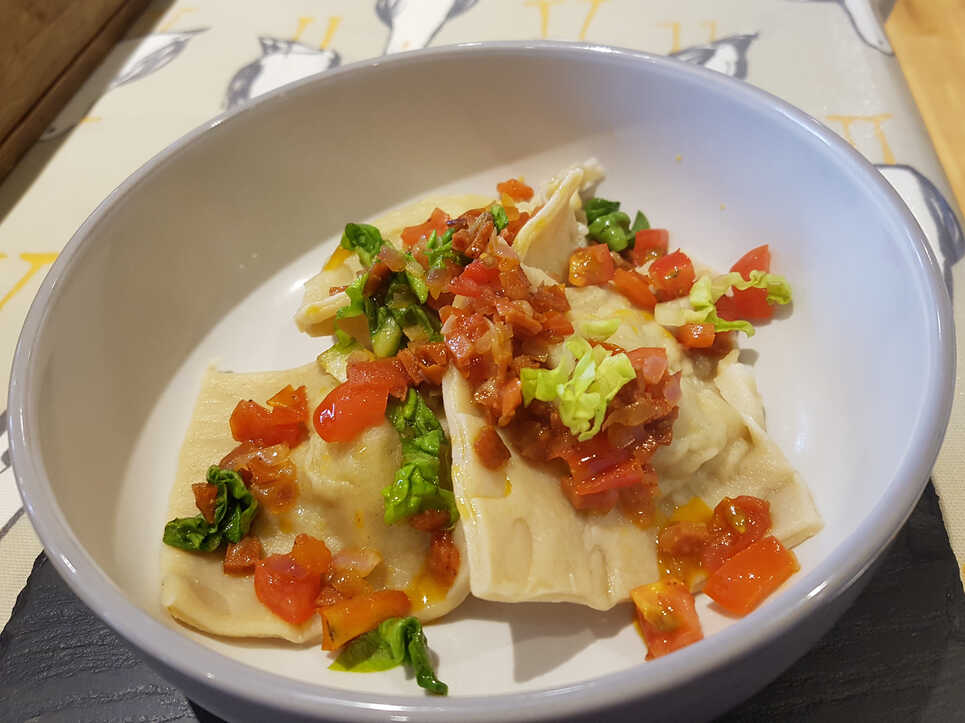Culinary Masterclass 3 - Pasta la Vista
My last class in this series 😢 since I'll be away for the final one, after the half-term holiday, in two weeks.
Do not worry though, dear reader, I have a mole in that class who will report back to me!
Ravioli are a variety of stuffed pasta made from pressing thin sheets of pasta dough together enclosing the stuffing, and are traditionally square, to distinguish them from Italy's many, many other exotic filled pasta shapes.
Surprisingly they were actually originally called rauioles and invented in Britain by the Master-Chefs of Richard II around 1390 A.D. as recorded in The Forme of Cury - A Roll of Ancient English Cookery.
At least according to Cucina Toscana.
In fact, I've been unable to confirm this in my texts of The Forme of Cury, but there are other versions out there, so perhaps it's true.
Seriously though, ravioli really seem to have been made at least as early as the 14th Century in Northern Italy - around Lombardy and Piedmont - and the name may be derived from the Italian riavvolgere, meaning to wrap.
Kind of.
Ravioli are usually made flat on one side and mounded on the other, and you can use a terrifically handy ravioli press to help create their shape. You press the first sheet over the mould creating pockets for the filling, dampen the joining surfaces, then roll the second sheet over the top.
The class did not have access to any of these 🙁
You need to squeeze most of the air out of the filled ravioli pockets so they don't pop when cooked, and the fillings need to be fairly dry, or their liquid will prevent the sheets from holding together and will leak out when boiled.
Finally you need to cut out the individual pasta shapes. Now usually you might use a nice fluted pastry wheel to do this, but we didn't have any of those either.
So just use a knife.
If you haven't used a fancy press, you can decorate the cut ravioli edges by pressing them with the tines of a fork.
Once the ravioli are all prepared, they only take about three minutes to cook in a pot of boiling water.
They're pretty much ready when they float up to the top, though you can cut into one to check: If there's no starchy line down the centre of the pasta then the ravioli is done.
If you need to keep them for a short period of time it's best to sprinkle the ravioli generously with flour or coarse semolina to stop them sticking together.
Longer than a day or so in the fridge and you would be better freezing them - they will then keep for months, and are easily cooked straight from frozen.
Although Lee didn't really include instructions for a sauce to use with the ravioli, I've added some suggestions in the recipes below.
He did demonstrate a creamy mushroom sauce to go with his creamy mushroom-stuffed ravioli, but I certainly wouldn't recommend that approach.
If you're going to have pretty much the same sauce on the outside of your filled pasta as you have on the inside, you might just as well use tagliatelle.
What you really want is a dressing which nicely contrasts or complements the filling.
So off you go and develop one!
Do not worry though, dear reader, I have a mole in that class who will report back to me!
Ravioli are a variety of stuffed pasta made from pressing thin sheets of pasta dough together enclosing the stuffing, and are traditionally square, to distinguish them from Italy's many, many other exotic filled pasta shapes.
Surprisingly they were actually originally called rauioles and invented in Britain by the Master-Chefs of Richard II around 1390 A.D. as recorded in The Forme of Cury - A Roll of Ancient English Cookery.
At least according to Cucina Toscana.
In fact, I've been unable to confirm this in my texts of The Forme of Cury, but there are other versions out there, so perhaps it's true.
Seriously though, ravioli really seem to have been made at least as early as the 14th Century in Northern Italy - around Lombardy and Piedmont - and the name may be derived from the Italian riavvolgere, meaning to wrap.
Kind of.
Ravioli are usually made flat on one side and mounded on the other, and you can use a terrifically handy ravioli press to help create their shape. You press the first sheet over the mould creating pockets for the filling, dampen the joining surfaces, then roll the second sheet over the top.
The class did not have access to any of these 🙁
You need to squeeze most of the air out of the filled ravioli pockets so they don't pop when cooked, and the fillings need to be fairly dry, or their liquid will prevent the sheets from holding together and will leak out when boiled.
Finally you need to cut out the individual pasta shapes. Now usually you might use a nice fluted pastry wheel to do this, but we didn't have any of those either.
So just use a knife.
If you haven't used a fancy press, you can decorate the cut ravioli edges by pressing them with the tines of a fork.
Once the ravioli are all prepared, they only take about three minutes to cook in a pot of boiling water.
They're pretty much ready when they float up to the top, though you can cut into one to check: If there's no starchy line down the centre of the pasta then the ravioli is done.
If you need to keep them for a short period of time it's best to sprinkle the ravioli generously with flour or coarse semolina to stop them sticking together.
Longer than a day or so in the fridge and you would be better freezing them - they will then keep for months, and are easily cooked straight from frozen.
Although Lee didn't really include instructions for a sauce to use with the ravioli, I've added some suggestions in the recipes below.
He did demonstrate a creamy mushroom sauce to go with his creamy mushroom-stuffed ravioli, but I certainly wouldn't recommend that approach.
If you're going to have pretty much the same sauce on the outside of your filled pasta as you have on the inside, you might just as well use tagliatelle.
What you really want is a dressing which nicely contrasts or complements the filling.
So off you go and develop one!
menu
Pasta for Ravioli
ingredient pasta veg
Since egg sizes differ, you're probably not going to get quite the right ratio of flour to eggs without weighing the beaten fluid.
So best to start by holding some flour in reserve, then add any extra flour you need to the dough once you've mixed through the eggs and olive oil.
You could actually use any ratio of whole eggs to egg yolks, including just eggs, but adding extra yolks give a richer result.
Pasta is best made from fine durum wheat flour, or semolina. Though this variety contains a lot of protein, it lacks the characteristic DNA found in bread wheat, so the gluten it develops is stronger and less elastic; better for holding its shape.
The Italian 00 grade just means that the (whichever) flour is finely milled.
So best to start by holding some flour in reserve, then add any extra flour you need to the dough once you've mixed through the eggs and olive oil.
You could actually use any ratio of whole eggs to egg yolks, including just eggs, but adding extra yolks give a richer result.
Pasta is best made from fine durum wheat flour, or semolina. Though this variety contains a lot of protein, it lacks the characteristic DNA found in bread wheat, so the gluten it develops is stronger and less elastic; better for holding its shape.
The Italian 00 grade just means that the (whichever) flour is finely milled.
Makes enough for 16-32 raviolis
Ingredients
- 300g '00' fine flour
- 2 eggs plus 2 egg yolks
- splash of olive oil
Mix together the ingredients, using just enough flour to make a springy dough that is not sticky and coheres into a ball, cleaning the bowl.
Cover and set aside for half an hour or so to rest.
Dust your pasta rolling machine with flour You do have a pasta rolling machine don't you? and adjust to the widest setting.
Pinch off a quarter of the rested dough and flatten it with a rolling pin so it's thin enough to run through the machine.
Roll the dough through the machine on gradually reducing widths, until the sheet is almost transparent.
Fill with the stuffing of your choice.
Cover and set aside for half an hour or so to rest.
Dust your pasta rolling machine with flour You do have a pasta rolling machine don't you? and adjust to the widest setting.
Pinch off a quarter of the rested dough and flatten it with a rolling pin so it's thin enough to run through the machine.
Roll the dough through the machine on gradually reducing widths, until the sheet is almost transparent.
You might fold the first sheet up and run it back through the machine a couple of times to get the extrusion smooth and tidy.
Keep the rolled sheet under greaseproof paper or a damp cloth while you roll the rest of the dough.Fill with the stuffing of your choice.
Mushroom Ravioli
main pasta veg mushroom
This stuffing is ideal mixed with ricotta (drained of excess liquid).
But we didn't have any of that, so we just made a creamy filling.
If you wanted to stuff all of the dough made from 300g of flour, you'd need a huge quantity of mushrooms, and the rest.
We had a third of a punnet of wild mushrooms - about 50g of mushrooms - which is enough to make maybe a half dozen ravioli.
But we didn't have any of that, so we just made a creamy filling.
If you wanted to stuff all of the dough made from 300g of flour, you'd need a huge quantity of mushrooms, and the rest.
We had a third of a punnet of wild mushrooms - about 50g of mushrooms - which is enough to make maybe a half dozen ravioli.
Fills about 20 ravioli for 2-4 people
Ingredients
- 150g mixed wild mushrooms
- garlic
- tarragon
- salt & pepper
- ricotta, drained if you had any
- double cream
Chop domestic mushrooms, or tear wild ones into pieces.
Slice some garlic.
Roughly chop tarragon leaves.
Heat a knob of butter or oil in a saucepan and sweat the mushrooms and the garlic until the mushrooms soften.
Add only enough double cream to moisten the pan, then cook gently for a few minutes to thicken the sauce.
Set the filling aside. In the fridge if you like.
Take a sheet of pasta, using a teaspoon to make small piles of the cooled filling in a grid across the pasta, use a wet brush to moisten the pasta areas around the filling, then lay over another sheet. Carefully squeeze the air out of the filling pockets, press the pasta together around them, then cut the ravioli out using a knife or a pizza cutter.
Trim them into tidy squares.
Serve immediately with a dressing of your choice:
Suggested Dressings:
Slice some garlic.
Roughly chop tarragon leaves.
Heat a knob of butter or oil in a saucepan and sweat the mushrooms and the garlic until the mushrooms soften.
Add only enough double cream to moisten the pan, then cook gently for a few minutes to thicken the sauce.
You don't want the filling to be too wet.
Add ricotta, if you have any!
Off the heat, season and mix in the chopped tarragon.Add ricotta, if you have any!
Set the filling aside. In the fridge if you like.
Take a sheet of pasta, using a teaspoon to make small piles of the cooled filling in a grid across the pasta, use a wet brush to moisten the pasta areas around the filling, then lay over another sheet. Carefully squeeze the air out of the filling pockets, press the pasta together around them, then cut the ravioli out using a knife or a pizza cutter.
Trim them into tidy squares.
Decorate the edge using the tines of a fork, if you like.
To cook - simmer for three minutes or so until they float to the top, then scoop them out and drain or dry on kitchen paper.Serve immediately with a dressing of your choice:
Suggested Dressings:
- Brown butter with sage.
- Fry more mushrooms in olive oil, add minced shallots, minced garlic, deglaze with Marsala wine, add double cream, grated parmesan, chopped parsley.
- Fry minced shallot and garlic in olive oil add chilli flakes, tomato paste, chilli flakes, tomato purée, then add vodka, then cream, and garnish with grated parmesan and basil leaves. À la So Much Food
- Fry shallot then garlic in butter, deglaze with Amontillado sherry, add cream then mix in a soft blue cheese. Careful - you can have too much blue cheese! butter, shallots, garlic, (sherry?), cream, blue cheese
Crab Ravioli
pasta main fish
You could also add ricotta to this filling. If you had any!
Be gentle with the lime - you don't want the filling to be too wet or the ravioli won't seal up.
Be gentle with the lime - you don't want the filling to be too wet or the ravioli won't seal up.
Fills about 20 ravioli for 2-4 people.
Ingredients
- 150g white crab meat
- lime juice perhaps add some zest?
- chives, finely chopped finely minced spring onions would also work
- pepper & a little salt
Pick over the shredded white crab meat to check for errant pieces of shell
I'm looking at you Dr Collin.
Mix with some finely chopped chives and a squeeze of lime juice.
Season carefully with pepper and a little salt.
Chill until using.
Take a sheet of pasta, using a teaspoon to make small piles of the filling in a grid across the pasta, use a wet brush to moisten the pasta areas around the filling, then lay over another sheet. Carefully squeeze the air out of the filling pockets, press the pasta together around them, then cut the ravioli out using a knife or a pizza cutter.
Trim them into tidy squares.
Serve immediately with a dressing of your choice:
Suggested Dressings:
Mix with some finely chopped chives and a squeeze of lime juice.
Season carefully with pepper and a little salt.
Chill until using.
Take a sheet of pasta, using a teaspoon to make small piles of the filling in a grid across the pasta, use a wet brush to moisten the pasta areas around the filling, then lay over another sheet. Carefully squeeze the air out of the filling pockets, press the pasta together around them, then cut the ravioli out using a knife or a pizza cutter.
Trim them into tidy squares.
Decorate the edge using the tines of a fork, if you like.
To cook - simmer for three minutes or so until they float to the top, then scoop them out and drain or dry on kitchen paper.Serve immediately with a dressing of your choice:
Suggested Dressings:
- Fry finely minced chorizo and shallots in a little olive oil, add tomato chopped small, add a drizzle more olive oil and a squirt of lime juice.
- Browned butter with a squeeze of lemon juice.
- Fry shallots and tomato paste in olive oil, add chilli flakes if you like, deglaze with Vermouth or saffron dissolved in a little hot stock, add double cream. À la Garlic & Zest.
Lee made a sauce of crab, red pepper, olive oil and lime juice. But I didn't think it really worked with the ravioli.
Sorry Lee!
Sorry Lee!

